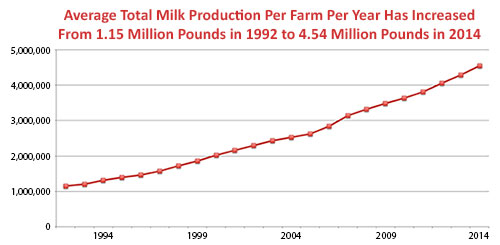
Ever-increasing herd size and production per cow will continue to reshape the U.S. dairy industry.
"Small" is a very relative term in the dairy industry – and is getting bigger every year.
Growth is happening in the form of fewer farms, more cows per herd, and more milk per cow. One of the most impressive measurements is total production per farm, which last year was nearly four times bigger than in 1992. It is a trend that is sure to continue because:
- Production per cow virtually never goes down. It has happened only once in the last 30 years: a 45-pound dip in 2001. During that time, however, the average increase has been 308 pounds per cow per year. (In the last 10 years, the average has been 329 pounds.)
The message here is important: An average gain of just 300 pounds per year means rolling herd average in the U.S. (22,258 pounds in 2014) will be 24,000 pounds in 2020. - Since licensed dairy numbers began being tracked in 1992, average U.S. herd size has never gone down. In 1992, it was 75 head; in 2014, it was 204 head. From 1992 to 2003, the average gain was four cows per year; since then the average gain has been 6.8.
In other words, the average U.S. dairy herd size of 204 cows in 2014 will likely be around 245 cows in 2020 and around 313 cows in 2030. - Herds that are growing faster, plus cows becoming more productive faster, means dairies will be making more total milk every year.
That is growth that is important for producers to begin planning for now in terms of housing, equipment, facilities and especially management.
(c) Hoard's Dairyman Intel 2015
March 9, 2015








